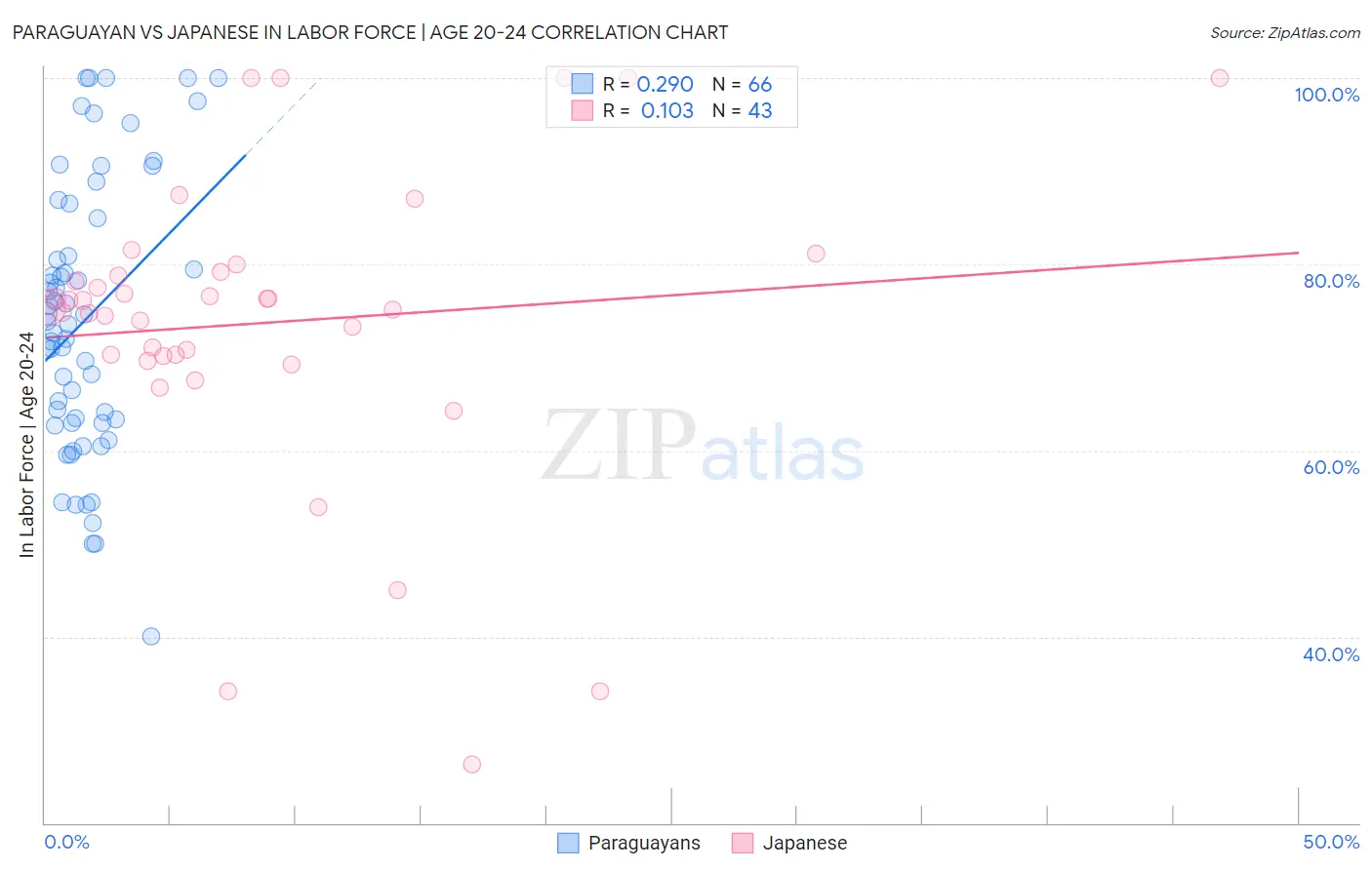Paraguayan vs Japanese In Labor Force | Age 20-24
COMPARE
Paraguayan
Japanese
In Labor Force | Age 20-24
In Labor Force | Age 20-24 Comparison
Paraguayans
Japanese
73.7%
IN LABOR FORCE | AGE 20-24
0.8/ 100
METRIC RATING
257th/ 347
METRIC RANK
75.3%
IN LABOR FORCE | AGE 20-24
68.7/ 100
METRIC RATING
160th/ 347
METRIC RANK
Paraguayan vs Japanese In Labor Force | Age 20-24 Correlation Chart
The statistical analysis conducted on geographies consisting of 95,113,378 people shows a weak positive correlation between the proportion of Paraguayans and labor force participation rate among population between the ages 20 and 24 in the United States with a correlation coefficient (R) of 0.290 and weighted average of 73.7%. Similarly, the statistical analysis conducted on geographies consisting of 249,162,424 people shows a poor positive correlation between the proportion of Japanese and labor force participation rate among population between the ages 20 and 24 in the United States with a correlation coefficient (R) of 0.103 and weighted average of 75.3%, a difference of 2.1%.

In Labor Force | Age 20-24 Correlation Summary
| Measurement | Paraguayan | Japanese |
| Minimum | 40.0% | 26.3% |
| Maximum | 100.0% | 100.0% |
| Range | 60.0% | 73.7% |
| Mean | 74.1% | 73.7% |
| Median | 73.7% | 75.3% |
| Interquartile 25% (IQ1) | 63.0% | 70.1% |
| Interquartile 75% (IQ3) | 85.0% | 79.2% |
| Interquartile Range (IQR) | 22.0% | 9.1% |
| Standard Deviation (Sample) | 14.7% | 16.2% |
| Standard Deviation (Population) | 14.6% | 16.0% |
Similar Demographics by In Labor Force | Age 20-24
Demographics Similar to Paraguayans by In Labor Force | Age 20-24
In terms of in labor force | age 20-24, the demographic groups most similar to Paraguayans are Spanish American Indian (73.7%, a difference of 0.020%), Egyptian (73.7%, a difference of 0.040%), Dutch West Indian (73.7%, a difference of 0.040%), Immigrants from Pakistan (73.8%, a difference of 0.060%), and Immigrants from Turkey (73.7%, a difference of 0.070%).
| Demographics | Rating | Rank | In Labor Force | Age 20-24 |
| Immigrants | Belgium | 1.3 /100 | #250 | Tragic 73.9% |
| Immigrants | Egypt | 1.2 /100 | #251 | Tragic 73.8% |
| Immigrants | Kazakhstan | 1.1 /100 | #252 | Tragic 73.8% |
| Arapaho | 1.0 /100 | #253 | Tragic 73.8% |
| Ute | 1.0 /100 | #254 | Tragic 73.8% |
| Immigrants | Pakistan | 0.9 /100 | #255 | Tragic 73.8% |
| Spanish American Indians | 0.8 /100 | #256 | Tragic 73.7% |
| Paraguayans | 0.8 /100 | #257 | Tragic 73.7% |
| Egyptians | 0.7 /100 | #258 | Tragic 73.7% |
| Dutch West Indians | 0.7 /100 | #259 | Tragic 73.7% |
| Immigrants | Turkey | 0.7 /100 | #260 | Tragic 73.7% |
| Houma | 0.6 /100 | #261 | Tragic 73.7% |
| Asians | 0.6 /100 | #262 | Tragic 73.7% |
| Immigrants | Asia | 0.5 /100 | #263 | Tragic 73.6% |
| Immigrants | Haiti | 0.5 /100 | #264 | Tragic 73.6% |
Demographics Similar to Japanese by In Labor Force | Age 20-24
In terms of in labor force | age 20-24, the demographic groups most similar to Japanese are South American Indian (75.3%, a difference of 0.010%), Immigrants from Bolivia (75.3%, a difference of 0.040%), Immigrants from El Salvador (75.3%, a difference of 0.050%), Immigrants from Western Europe (75.3%, a difference of 0.050%), and New Zealander (75.2%, a difference of 0.050%).
| Demographics | Rating | Rank | In Labor Force | Age 20-24 |
| Guatemalans | 72.3 /100 | #153 | Good 75.3% |
| Osage | 72.3 /100 | #154 | Good 75.3% |
| Immigrants | Guatemala | 71.9 /100 | #155 | Good 75.3% |
| Immigrants | El Salvador | 71.7 /100 | #156 | Good 75.3% |
| Immigrants | Western Europe | 71.5 /100 | #157 | Good 75.3% |
| Immigrants | Bolivia | 71.0 /100 | #158 | Good 75.3% |
| South American Indians | 69.0 /100 | #159 | Good 75.3% |
| Japanese | 68.7 /100 | #160 | Good 75.3% |
| New Zealanders | 65.4 /100 | #161 | Good 75.2% |
| Immigrants | Romania | 64.6 /100 | #162 | Good 75.2% |
| Costa Ricans | 64.2 /100 | #163 | Good 75.2% |
| Bolivians | 64.0 /100 | #164 | Good 75.2% |
| Afghans | 63.5 /100 | #165 | Good 75.2% |
| Cambodians | 60.5 /100 | #166 | Good 75.2% |
| Immigrants | South Eastern Asia | 57.5 /100 | #167 | Average 75.1% |